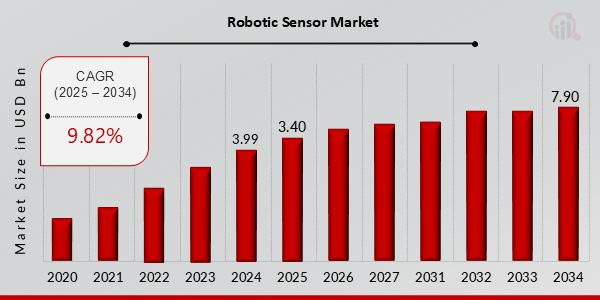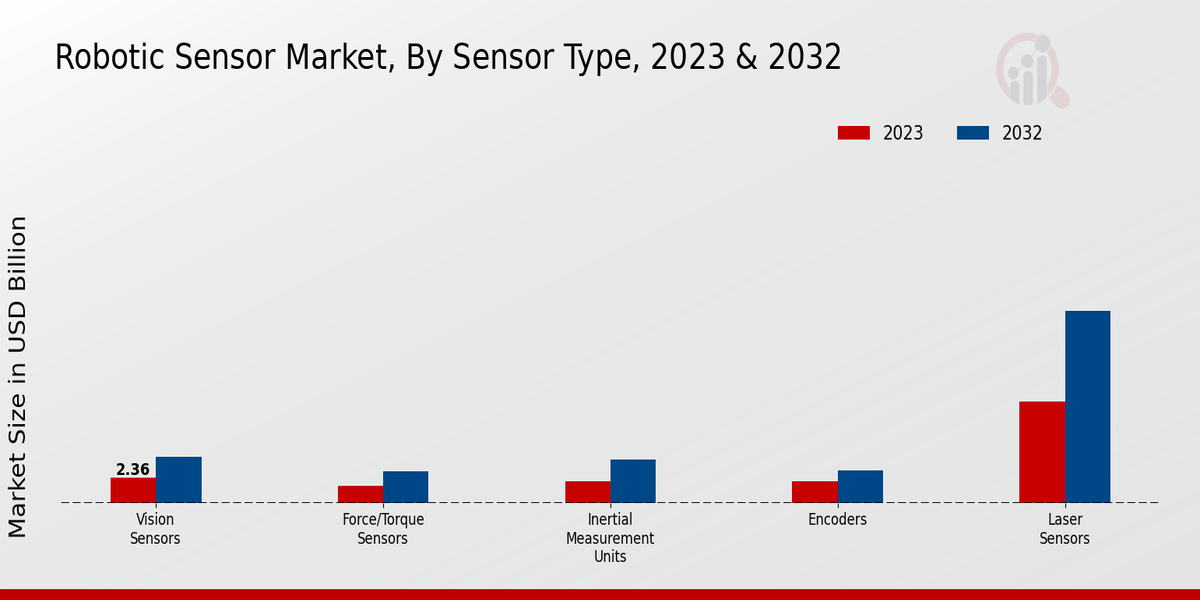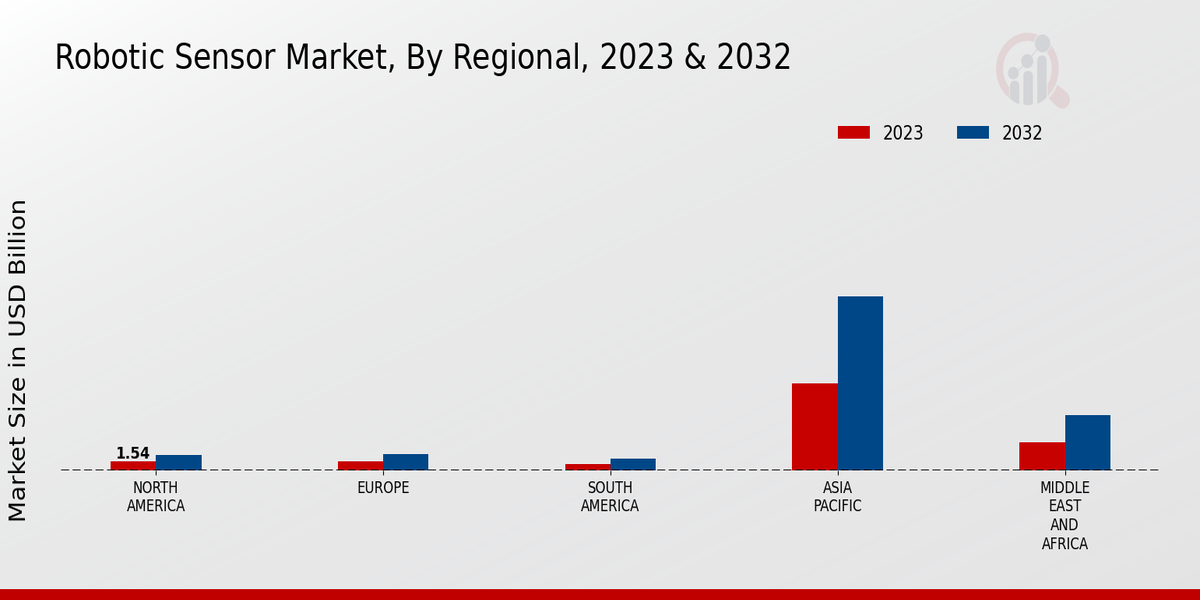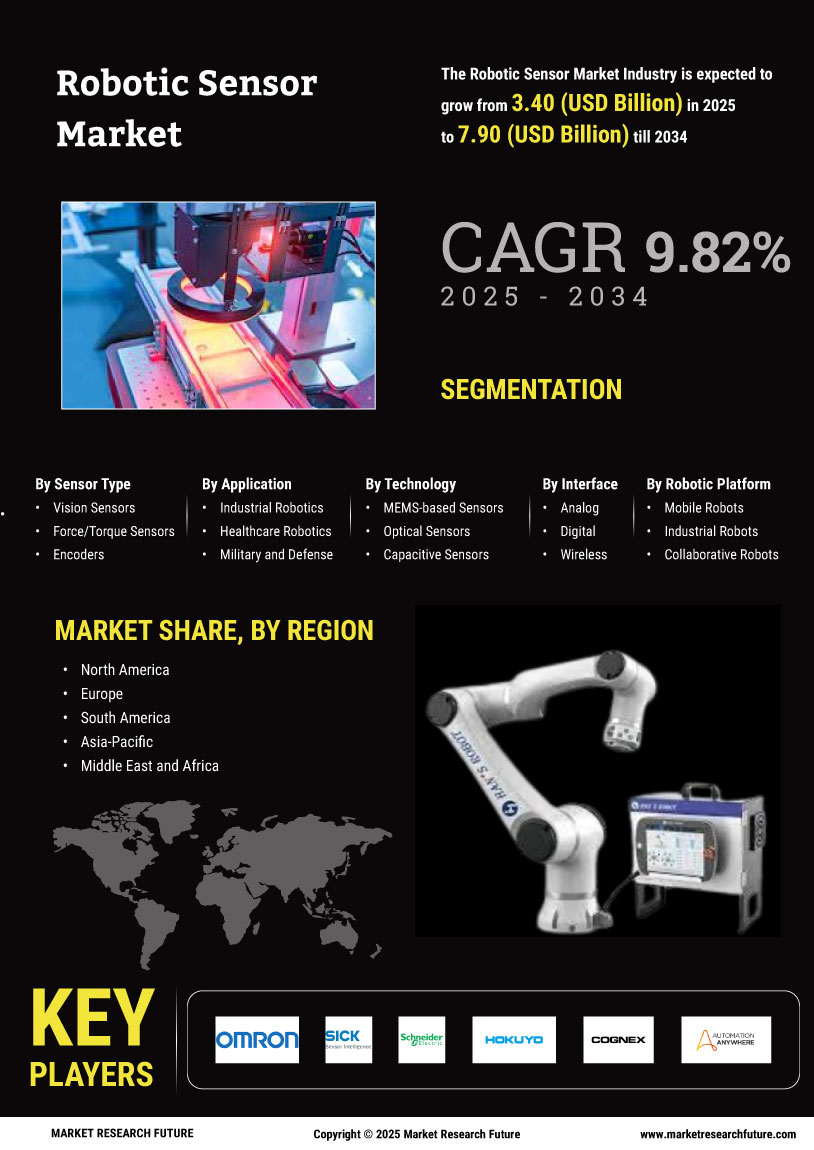Global Robotic Sensor Market Overview
Robotic Sensor Market Size was estimated at 3.99 (USD Billion) in 2024. The Robotic Sensor Market Industry is expected to grow from 3.40 (USD Billion) in 2025 to 7.90 (USD Billion) till 2034, exhibiting a compound annual growth rate (CAGR) of 9.82% during the forecast period (2025 - 2034).
Key Robotic Sensor Market Trends Highlighted
The robotics sensor market exhibits an array of notable trends that shape its growth trajectory. The integration of advanced technologies, such as artificial intelligence (AI) and machine learning (ML), enhances the accuracy, precision, and reliability of robotic sensors. This enables robots to perform complex tasks more efficiently, opening up new possibilities for automation in various industries. The increasing demand for collaborative robots, which work alongside human workers, also drives the market. These robots require precise sensing capabilities to ensure safe and efficient human-robot interaction.
Key market drivers include the growing adoption of robotics across industries, the need for increased productivity and efficiency, and government initiatives promoting automation. Opportunities lie in the development of multi-modal sensors that can detect different parameters, the integration of sensor data with cloud computing for real-time analysis, and the exploration of emerging applications in healthcare, agriculture, and smart cities. Recent trends include the miniaturization of sensors for compact robotic designs, the use of lightweight and energy-efficient sensors for extended operation, and the focus on ruggedized sensors for harsh environments.

Source: Primary Research, Secondary Research, MRFR Database and Analyst Review
Robotic Sensor Market Drivers
Growing Demand for Automation in the Industrial Sector
The increasing adoption of automation in various industries, such as manufacturing, automotive, and healthcare, is a major driver of the Robotic Sensor Market Industry. Robotic sensors play a crucial role in automating tasks, improving efficiency, and enhancing productivity. As industries strive to optimize their operations and reduce costs, the demand for robotic sensors is expected to continue to grow significantly. The integration of robotic sensors into automated systems enables precise control, real-time data acquisition, and decision-making, leading to improved operational efficiency and product quality. Furthermore, the advancements in sensor technologies, such as the development of miniaturized, low-power, and high-performance sensors, are furthering the adoption of robotic sensors in industrial applications.
Advancements in Artificial Intelligence (AI) and Machine Learning (ML)
The rapid advancements in artificial intelligence (AI) and machine learning (ML) are significantly contributing to the growth of the Robotic Sensor Market Industry. AI and ML algorithms enable robotic sensors to analyze complex data, identify patterns, and make informed decisions. By integrating AI and ML capabilities, robotic sensors can adapt to changing environments, learn from experiences, and perform tasks with greater autonomy. This enhanced intelligence allows robotic sensors to perform tasks that were previously impossible, such as object recognition, navigation, and human-robot interaction. The integration of AI and ML in robotic sensors is expected to drive innovation and create new opportunities for growth in the market.
Increasing Adoption of Collaborative Robots
The rising adoption of collaborative robots, also known as cobots, is another key driver of the Robotic Sensor Market Industry. Cobots are designed to work alongside human workers, assisting them with tasks and enhancing their capabilities. Robotic sensors are essential components of cobots, enabling them to perceive their surroundings, interact with humans, and perform tasks safely and efficiently. The increasing adoption of cobots in various industries, such as manufacturing, healthcare, and logistics, is driving the demand for robotic sensors. Cobots provide numerous benefits, including improved productivity, reduced labor costs, and enhanced worker safety, which are expected to continue to fuel the growth of the robotic sensor market.
Robotic Sensor Market Segment Insights
Robotic Sensor Market Sensor Type Insights
The market is segmented based on sensor type, which includes vision sensors, force/torque sensors, inertial measurement units (IMUs), encoders, laser sensors, and ultrasonic sensors. Vision Sensors Vision sensors are cameras that capture images or videos of the environment and use algorithms to process the visual data. They are used in a variety of robotic applications, such as object recognition, navigation, and inspection. The global market for vision sensors is expected to reach a value of USD 12.5 billion by 2032, exhibiting a CAGR of 8.2% during the forecast period.Force/Torque Sensors Force/torque sensors measure the force or torque applied to a robotic arm or gripper. They are used in a variety of robotic applications, such as assembly, welding, and material handling. The global market for force/torque sensors is expected to reach a value of USD 5.2 billion by 2032, exhibiting a CAGR of 7.5% during the forecast period. Inertial Measurement Units (IMUs) Inertial measurement units (IMUs) measure the orientation and angular velocity of a robotic arm or gripper. They are used in a variety of robotic applications, such as navigation, stabilization, and control. The global market for IMUs is expected to reach a value of USD 4.1 billion by 2032, exhibiting a CAGR of 7.2% during the forecast period. Encoders Encoders measure the position or speed of a robotic arm or gripper. They are used in a variety of robotic applications, such as motion control, feedback, and safety.
The global market for encoders is expected to reach a value of USD 3.6 billion by 2032, exhibiting a CAGR of 7.0% during the forecast period. Laser Sensors Laser sensors measure the distance or position of an object using a laser beam. They are used in a variety of robotic applications, such as navigation, obstacle avoidance, and measurement. The global market for laser sensors is expected to reach a value of USD 2.9 billion by 2032, exhibiting a CAGR of 6.8% during the forecast period. Ultrasonic Sensors Ultrasonic sensors measure the distance or position of an object using ultrasonic waves. They are used in a variety of robotic applications, such as navigation, obstacle avoidance, and level measurement. The global market for ultrasonic sensors is expected to reach a value of USD 2.2 billion by 2032, exhibiting a CAGR of 6.5% during the forecast period.

Source: Primary Research, Secondary Research, MRFR Database and Analyst Review
Robotic Sensor Market Application Insights
The Robotic Sensor Market segmentation by Application includes Industrial Robotics, Healthcare Robotics, Military and Defense, Consumer Robotics, and Commercial Robotics. Industrial Robotics held the largest market share in 2021 and is expected to continue its dominance during the forecast period. The growth is attributed to the rising adoption of robots in manufacturing and assembly lines across various industries, including automotive, electronics, and food and beverage. Healthcare Robotics is another significant segment, with increasing demand for surgical robots and rehabilitation systems, leading to improved patient outcomes and reduced healthcare costs. Military and Defense applications are also driving market growth due to advancements in autonomous systems and unmanned vehicles for surveillance and reconnaissance operations. Consumer Robotics, including home service robots, delivery robots, and entertainment robots, is gaining traction due to increasing affordability and technological advancements. Commercial Robotics is also witnessing growth in sectors such as retail, hospitality, and logistics as businesses seek to improve efficiency and customer experience.
Robotic Sensor Market Technology Insights
The Robotic Sensor Market segmentation by Technology is expected to grow significantly over the forecast period. The MEMS-based Sensors segment is expected to dominate the market in 2023 and is projected to reach USD 12.65 billion by 2032, exhibiting a CAGR of 8.2%. The growth of this segment can be attributed to the increasing adoption of MEMS-based sensors in various robotic applications, such as navigation, mapping, and object recognition. The optical sensors segment is expected to witness a significant growth rate during the forecast period, owing to the rising demand for high-precision and reliable sensors in industrial automation and healthcare applications. The capacitive Sensors segment is anticipated to grow steadily over the forecast period, driven by the increasing use of these sensors in robotics for proximity detection and collision avoidance. The inductive Sensors segment is projected to grow at a moderate pace during the forecast period, primarily due to the increasing adoption of these sensors in mobile robots and autonomous vehicles. The piezoelectric sensors segment is expected to witness a steady growth rate over the forecast period, driven by the rising demand for these sensors in robotics for force and pressure sensing applications.
Robotic Sensor Market Interface Insights
The Interface segment is further divided into Analog, Digital, Wireless, and Fieldbus. The Analog segment accounted for the largest share of the Robotic Sensor Market in 2023, and it is expected to continue to dominate the market throughout the forecast period. The increasing adoption of analog sensors in robotics is primarily due to their low cost, low power consumption, and high reliability. The Digital segment is expected to grow at the highest CAGR during the forecast period, owing to the growing demand for digital sensors in advanced robotics applications. Digital sensors offer higher accuracy, precision, and resolution than analog sensors, making them ideal for applications such as autonomous navigation, object recognition, and gesture control. The Wireless segment is expected to witness significant growth due to the increasing popularity of wireless sensor networks in robotics. Wireless sensors provide greater flexibility and mobility to robots, enabling them to operate in remote or hazardous environments. The Fieldbus segment is expected to account for a significant share of the Robotic Sensor Market due to its ability to connect multiple sensors and devices on a single network. Fieldbus sensors are widely used in industrial automation applications, where they provide reliable and efficient data transmission.
Robotic Sensor Market Robotic Platform Insights
The Robotic Platform segment is a key segment of the Robotic Sensor Market, accounting for a significant share of the market revenue. The segment is further divided into various sub-segments, including Mobile Robots, Industrial Robots, Collaborative Robots, Humanoid Robots, and Exoskeletons. Each sub-segment has its own unique characteristics, applications, and growth drivers. Mobile Robots: Mobile robots are autonomous robots that can navigate their environment without human intervention. They are used in a variety of applications, such as warehouse automation, logistics, and healthcare. The market for mobile robots is expected to grow rapidly in the coming years, driven by the increasing demand for automation and the development of new technologies. Industrial Robots: Industrial robots are used in manufacturing processes to perform repetitive tasks with high accuracy and speed. They are commonly used in industries such as automotive, electronics, and food and beverage. The market for industrial robots is expected to remain stable in the coming years, driven by the increasing demand for automation and the need to improve productivity.
Collaborative Robots: Collaborative robots, also known as cobots, are designed to work alongside human workers in a shared workspace. They are typically used in applications where humans and robots need to work closely together, such as assembly and inspection. The market for collaborative robots is expected to grow significantly in the coming years, driven by the increasing demand for automation and the need to improve safety in the workplace. Humanoid Robots: Humanoid robots are robots that are designed to resemble humans in appearance and behavior. They are used in a variety of applications, such as entertainment, education, and healthcare. The market for humanoid robots is expected to grow slowly in the coming years, driven by the development of new technologies and the increasing demand for robots that can naturally interact with humans. Exoskeletons: Exoskeletons are wearable devices that can augment human strength and mobility. They are used in a variety of applications, such as healthcare, construction, and manufacturing. The market for exoskeletons is expected to grow rapidly in the coming years, driven by the increasing demand for assistive devices and the development of new technologies.
Robotic Sensor Market Regional Insights
Due to the increasing demand for robotics in various industries, the Robotic Sensor Market is expected to grow significantly in the coming years. Regionally, North America is anticipated to hold the largest market share, owing to the presence of major robotics companies and advanced manufacturing industries. Europe is expected to follow North America, driven by government initiatives and investments in robotics research and development. The APAC region is anticipated to witness the highest growth rate, driven by the rapid adoption of robotics in the manufacturing and healthcare industries. South America and MEA are expected to experience steady growth, with increasing demand for robotics in sectors such as mining, construction, and logistics. Key market players are focusing on developing innovative sensors and solutions to cater to the specific requirements of different industries.

Source: Primary Research, Secondary Research, MRFR Database and Analyst Review
Robotic Sensor Market Key Players And Competitive Insights
Major players in the Robotic Sensor Market industry are continuously striving to develop advanced and cost-effective sensors to meet the growing demand for improved robotic capabilities. Leading Robotic Sensor Market players are investing heavily in research and development to enhance the performance and functionality of their products. The Robotic Sensor Market development is driven by factors such as increasing adoption of robotics in various industries, rising demand for autonomous systems, and advancements in sensor technologies. The competitive landscape of the Robotic Sensor Market is characterized by a mix of established players and emerging startups. Omron is a leading global supplier of automation and control systems, including sensors for robotics. The company offers a wide range of sensors, including vision sensors, force sensors, and proximity sensors. Omron's sensors are known for their high precision, reliability, and durability.
The company has a strong global presence and serves a diverse range of industries, including automotive, electronics, and food and beverage.ABB is a leading provider of robotics and automation solutions. The company offers a range of sensors for robotics, including vision sensors, force sensors, and torque sensors. ABB's sensors are designed to provide accurate and reliable data, even in harsh environments. The company has a strong global presence and serves a diverse range of industries, including automotive, aerospace, and healthcare.
Key Companies in the Robotic Sensor Market Include
- OMRON Corporation
- SICK
- Schneider Electric
- Hokuyo Automation
- Cognex
- Automation Anywhere, Inc.
- Baumer Group
- ABB
- SICK AG
- FANUC
- MicroStrain, Inc.
- Adept Technology
- KEYENCE
- Velodyne LiDAR
- Rockwell Automation
Robotic Sensor Industry Developments
The Robotic Sensor Market is projected to reach USD 49.12 billion by 2032, exhibiting a CAGR of 7.87% during the forecast period (2024-2032). The market growth is primarily attributed to the increasing adoption of robotics in various industries, including manufacturing, healthcare, and logistics. The rising demand for collaborative robots and the integration of sensors in autonomous mobile robots are further driving the market growth. Recent developments in the market include the launch of new sensor technologies, such as 3D vision sensors and force/torque sensors, which enhance the capabilities of robots and expand their applications. Additionally, the growing adoption of IoT and cloud computing in robotics is creating new opportunities for data analysis and predictive maintenance, leading to improved efficiency and productivity.
Robotic Sensor Market Segmentation Insights
Robotic Sensor Market Sensor Type Outlook
- Vision Sensors
- Force/Torque Sensors
- Inertial Measurement Units (IMUs)
- Encoders
- Laser Sensors
- Ultrasonic Sensors
Robotic Sensor Market Application Outlook
- Industrial Robotics
- Healthcare Robotics
- Military and Defense
- Consumer Robotics
- Commercial Robotics
Robotic Sensor Market Technology Outlook
- MEMS-based Sensors
- Optical Sensors
- Capacitive Sensors
- Inductive Sensors
- Piezoelectric Sensors
Robotic Sensor Market Interface Outlook
- Analog
- Digital
- Wireless
- Fieldbus
Robotic Sensor Market Robotic Platform Outlook
- Mobile Robots
- Industrial Robots
- Collaborative Robots
- Humanoid Robots
- Exoskeletons
Robotic Sensor Market Regional Outlook
- North America
- Europe
- South America
- Asia-Pacific
- Middle East and Africa
|
Report Attribute/Metric
|
Details
|
|
Market Size 2024
|
USD 3.99 Billion
|
|
Market Size 2025
|
USD 3.40 Billion
|
|
Market Size 2034
|
USD 7.90 Billion
|
|
Compound Annual Growth Rate (CAGR)
|
9.82% (2025-2034)
|
|
Base Year
|
2024
|
|
Market Forecast Period
|
2025-2034
|
|
Historical Data
|
2020-2023
|
| Market Forecast Units |
USD Billion |
| Key Companies Profiled |
OMRON Corporation, SICK, Schneider Electric, Hokuyo Automation, Cognex, Automation Anywhere, Inc., Baumer Group, ABB, SICK AG, FANUC, MicroStrain, Inc., Adept Technology, KEYENCE, Velodyne LiDAR, Rockwell Automation |
| Segments Covered |
Sensor Type, Application, Technology, Interface, Robotic Platform, Regional |
| Key Market Opportunities |
Increased Automation in Manufacturing.Rising Adoption of Collaborative Robots.Growing Healthcare Sector.Advancements in Artificial Intelligence.Government Support for Robotics |
| Key Market Dynamics |
Increased demand for automation and efficiency.Advancements in sensor technology.Growing adoption in various industries.Government initiatives and investments.Competitive pricing and cost reductions |
| Countries Covered |
North America, Europe, APAC, South America, MEA |
Frequently Asked Questions (FAQ) :
The Robotic Sensor Market is expected to reach an overall valuation of 7.90 billion USD in 2034.
The CAGR of the Robotic Sensor Market is projected to be 9.82% from 2025 to 2034.
North America held the largest market share in the Robotic Sensor Market in 2023.
Robotic sensors are used in various applications, including industrial automation, healthcare, manufacturing, and logistics.
The key competitors in the Robotic Sensor Market include ABB, Bosch, SICK, and OMRON.
The major factors driving the growth of the Robotic Sensor Market include the increasing demand for automation in various industries and the growing adoption of robotics in healthcare and manufacturing.
The challenges facing the Robotic Sensor Market include the high cost of robotic sensors and the need for skilled professionals to operate and maintain these sensors.
The key trends in the Robotic Sensor Market include the development of new sensor technologies, such as MEMS and CMOS sensors, and the increasing use of robotic sensors in collaborative applications.
The Robotic Sensor Market is expected to reach an overall valuation of 6.17 billion USD in 2032.
Robotic sensors have the potential to be used in a wide range of applications, including autonomous vehicles, wearable devices, and smart homes.

















